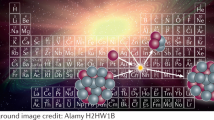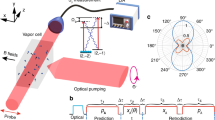Abstract
Hund's multiplicity rule, according to which a high spin state has a lower energy than any other state of lower spin arising from the same configuration, was deduced from atomic spectra immediately before the advent of modern quantum mechanics. Since then, the lower energy of the state of higher multiplicity has generally been explained by assuming greater electron repulsion in the lower spin states. Numerous calculations1–13 have shown, however, that the traditional explanation of Hund's rule is invalid. In every neutral species for which the requisite calculations have been carried out, the electron–electron repulsion, Vee, is greater in the high spin state, and the lower energy of the high spin state is due to its greater electron–nucleus attraction, Ven. I show here that Hund's rule is a consequence of the Fermi correlation between electrons with parallel spin which leads to less screening of the nucleus in the high spin state.
This is a preview of subscription content, access via your institution
Access options
Subscribe to this journal
Receive 51 print issues and online access
$199.00 per year
only $3.90 per issue
Buy this article
- Purchase on Springer Link
- Instant access to full article PDF
Prices may be subject to local taxes which are calculated during checkout
Similar content being viewed by others
References
Messmer, R. P. & Birss, F. W. J. phys. Chem. 73, 2085–2086 (1969).
Accad, Y., Pekeris, C. L., & Schiff, B. Phys. Rev. A4, 516–536 (1971).
Katriel, J. Theor. chim. Acta 23, 309–315 (1972).
Kohl, D. A. J. chem. Phys. 56, 4236–4238 (1972).
Boyd, R. J. & Coulson, C. A. J. Phys. B6, 782–793 (1973).
Colpa, J. P. & Islip, M. F. J. Molec. Phys. 25, 701–705 (1973).
Killingbeck, J. Molec. Phys. 25, 455–459 (1973).
Colbourn, E. A. J. Phys. B6, 2618–2624 (1973).
Colbourn, E. A. & Coulson, C. A. J. Phys. B7, 1574–1581 (1974).
Colbourn, E. A. J. Phys. B8, 1926–1933 (1975).
Colpa, J. P., Thakkar, A. J., Smith, V. H. Jr & Randle, P. Molec. Phys. 29, 1861–1875 (1975).
Shim, I. & Dahl, J. P. Theor. chim. Acta 48, 165–174 (1978).
Tatewaki, H. & Tanaka, K. J. chim. Phys. 60, 601–606 (1974).
Boyd, R. J. Theor. chim. Acta 33, 79–86 (1974).
Boyd, R. J. & Coulson, C. A. J. Phys. B7, 1805–1816 (1974).
Katriel, J. Phys. Rev. A5, 1990–1992 (1972).
Katriel, J. & Pauncz, R. Adv. Quantum Chem. 10, 143–185 (1977).
Boyd, R. J. Nature 250, 566–567 (1974).
Pichou, F., Huetz, A., Joyez, G., Landau, M. & Mazeau, J. J. Phys. B9, 933–944 (1976).
Author information
Authors and Affiliations
Rights and permissions
About this article
Cite this article
Boyd, R. A quantum mechanical explanation for Hund's multiplicity rule. Nature 310, 480–481 (1984). https://doi.org/10.1038/310480a0
Received:
Accepted:
Issue Date:
DOI: https://doi.org/10.1038/310480a0
This article is cited by
-
Isolation of dissolved organic matter from aqueous solution by precipitation with FeCl3: mechanisms and significance in environmental perspectives
Scientific Reports (2023)
-
Friedrich Hermann Hund: Humanist, Physicist, Teacher, Activist, Science Historian
Resonance (2022)
-
Orthogonality properties of states, configurations, and orbitals
Foundations of Chemistry (2022)
-
Term rules for simple metal clusters
Scientific Reports (2015)
-
Metal-enhanced Singlet Oxygen Generation: A Consequence of Plasmon Enhanced Triplet Yields
Journal of Fluorescence (2007)
Comments
By submitting a comment you agree to abide by our Terms and Community Guidelines. If you find something abusive or that does not comply with our terms or guidelines please flag it as inappropriate.



